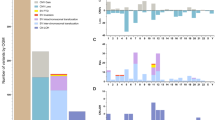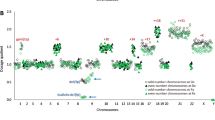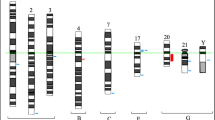Abstract
Although trisomy 8 as the sole chromosome aberration is the most common numerical abnormality in acute myeloid leukemia (AML) and myelodysplastic syndromes (MDS), little is known about its pathogenetic effects. Considering that +8 is a frequent secondary change in AML/MDS, cryptic – possibly primary – genetic aberrations may occur in cases with trisomy 8 as the apparently single anomaly. However, no such hidden anomalies have been reported. We performed a high-resolution genome-wide array-based comparative genome hybridization (array CGH) analysis of 10 AML/MDS cases with isolated +8, utilizing a 32K bacterial artificial chromosome array set, providing >98% coverage of the genome with a resolution of 100 kb. Array CGH revealed intrachromosomal imbalances, not corresponding to known genomic copy number polymorphisms, in 4/10 cases, comprising nine duplications and hemizygous deletions ranging in size from 0.5 to 2.2 Mb. A 1.8 Mb deletion at 7p14.1, which had occurred prior to the +8, was identified in MDS transforming to AML. Furthermore, a deletion including ETV6 was present in one case. The remaining seven imbalances involved more than 40 genes. The present results show that cryptic genetic abnormalities are frequent in trisomy 8-positive AML/MDS cases and that +8 as the sole cytogenetic aberration is not always the primary genetic event.
This is a preview of subscription content, access via your institution
Access options
Subscribe to this journal
Receive 12 print issues and online access
$259.00 per year
only $21.58 per issue
Buy this article
- Purchase on Springer Link
- Instant access to full article PDF
Prices may be subject to local taxes which are calculated during checkout

Similar content being viewed by others
References
Mitelman F, Johansson B, Mertens F . Mitelman database of chromosome aberrations in cancer. 2005. http://cgap.nci.nih.gov/Chromosomes/Mitelman.
Paulsson K, Säll T, Fioretos T, Mitelman F, Johansson B . The incidence of trisomy 8 as a sole chromosomal aberration in myeloid malignancies varies in relation to gender, age, prior iatrogenic genotoxic exposure, and morphology. Cancer Genet Cytogenet 2001; 130: 160–165.
Albin M, Björk J, Welinder H, Tinnerberg H, Mauritzson N, Johansson B et al. Acute myeloid leukemia and clonal chromosome aberrations in relation to past exposure to organic solvents. Scand J Work Environ Health 2000; 26: 482–491.
Grimwade D, Walker H, Oliver F, Wheatley K, Harrison C, Harrison G et al. The importance of diagnostic cytogenetics on outcome in AML: analysis of 1,612 patients entered into the MRC AML 10 trial. Blood 1998; 92: 2322–2333.
Wolman SR, Gundacker H, Appelbaum FR, Slovak ML . Impact of trisomy 8 (+8) on clinical presentation, treatment response, and survival in acute myeloid leukemia: a southwest oncology group study. Blood 2002; 100: 29–35.
Solé F, Espinet B, Sanz GF, Cervera J, Calasanz MJ, Luño E et al. Incidence, characterization and prognostic significance of chromosomal abnormalities in 640 patients with primary myelodysplastic syndromes. Br J Haematol 2000; 108: 346–356.
Maserati E, Aprili F, Vinante F, Locatelli F, Amendola G, Zatterale A et al. Trisomy 8 in myelodysplasia and acute leukemia is constitutional in 15–20% of cases. Genes Chromosomes Cancer 2002; 33: 93–97.
Nilsson L, Åstrand-Grundström I, Anderson K, Arvidsson I, Hokland P, Bryder D et al. Involvement and functional impairment of the CD34+CD38-Thy-1+ hematopoietic stem cell pool in myelodysplatic syndromes with trisomy 8. Blood 2002; 100: 259–267.
Schoch C, Kohlmann A, Dugas M, Kern W, Hiddemann W, Schnittger S et al. Genomic gains and losses influence expression levels of genes located within the affected regions: a study on acute myeloid leukemias with trisomy 8, 11, or 13, monosomy 7, or deletion 5q. Leukemia 2005; 19: 1224–1228.
Paulsson K, Fioretos T, Strömbeck B, Mauritzson N, Tanke HJ, Johansson B . Trisomy 8 as the sole chromosomal aberration in myelocytic malignancies: a multicolor and locus-specific fluorescence in situ hybridization study. Cancer Genet Cytogenet 2003; 140: 66–69.
Leroy H, Roumier C, Huyghe P, Biggio V, Fenaux P, Preudhomme C . CEBPA point mutations in hematological malignancies. Leukemia 2005; 19: 329–334.
Harada H, Harada Y, Niimi H, Kyo T, Kimura A, Inaba T . High incidence of somatic mutations in the AML1/RUNX1 gene in myelodysplastic syndrome and low blast percentage myeloid leukemia with myelodysplasia. Blood 2004; 103: 2316–2324.
Heller A, Brecevic L, Glaser M, Loncarevic IF, Gebhart E, Claussen U et al. Trisomy 8 as the sole chromosomal aberration in myelocytic malignancies: a comprehensive molecular cytogenetic analysis reveals no cryptic aberrations. Cancer Genet Cytogenet 2003; 146: 81–83.
Pinkel D, Segraves R, Sudar D, Clark S, Poole I, Kowbel D et al. High resolution analysis of DNA copy number variation using comparative genomic hybridization to microarrays. Nat Genet 1998; 20: 207–211.
Drazinic CM, Ercan-Sencicek AG, Gault LM, Hisama FM, Qumsiyeh MB, Nowak NJ et al. Rapid array-based genomic characterization of a subtle structural abnormality: a patient with psychosis and der(18)t(5;18)(p14.1;p11.23). Am J Med Genet 2005; 134A: 282–289.
Heidenblad M, Schoenmakers EFPM, Jonson T, Gorunova L, Veltman JA, van Kessel AG et al. Genome-wide array-based comparative genomic hybridization reveals multiple amplification targets and novel homozygous deletions in pancreatic carcinoma cell lines. Cancer Res 2004; 64: 3052–3059.
Cowell JK, Matsui S-I, Wang YD, LaDuca J, Conroy J, McQuaid D et al. Application of bacterial artificial chromosome array-based comparative genomic hybridization and spectral karyotyping to the analysis of glioblastoma multiforme. Cancer Genet Cytogenet 2004; 151: 36–51.
Rubio-Moscardo F, Climent J, Siebert R, Piris MA, Martín-Subero JI, Nieländer I et al. Mantle-cell lymphoma genotypes identified with CGH to BAC microarrays define a leukemic subgroup of disease and predict patient outcome. Blood 2005; 105: 4445–4454.
Krzywinski M, Bosdet I, Smailus D, Chiu R, Mathewson C, Wye N et al. A set of BAC clones spanning the human genome. Nucl Acids Res 2004; 32: 3651–3660.
Ishkanian AS, Malloff CA, Watson SK, deLeeuw RJ, Chi B, Coe BP et al. A tiling resolution DNA microarray with complete coverage of the human genome. Nat Genet 2004; 36: 299–303.
Yang YH, Dudoit S, Luu P, Lin DM, Peng V, Ngai J et al. Normalization for cDNA microarray data: a robust composite method addressing single and multiple slide systematic variation. Nucl Acids Res 2002; 30: e15.
Autio R, Hautaniemi S, Kauraniemi P, Yli-Harja O, Astola J, Wolf M et al. CGH-Plotter: MATLAB toolbox for CGH-data analysis. Bioinformatics 2003; 19: 1714–1715.
Saal LH, Troein C, Vallon-Christersson J, Gruvberger S, Borg Å, Peterson C . BioArray Software Environment (BASE): a platform for comprehensive management and analysis of microarray data. Genome Biol 2002; 3: software0003.
The Database of Genomic Variants 2005. http://projects.tcag.ca/variation/.
Kallioniemi O-P, Kallioniemi A, Piper J, Isola J, Waldman FM, Gray JW et al. Optimizing comparative genomic hybridization for analysis of DNA sequence copy number changes in solid tumors. Genes Chromosomes Cancer 1994; 10: 231–243.
Sebat J, Lakshmi B, Troge J, Alexander J, Young J, Lundin P et al. Large-scale copy number polymorphism in the human genome. Science 2004; 305: 525–528.
Andreasson P, Johansson B, Arheden K, Billström R, Mitelman F, Höglund M . Deletions of CDKN1B and ETV6 in acute myeloid leukemia and myelodysplastic syndromes without cytogenetic evidence of 12p abnormalities. Genes Chromosomes Cancer 1997; 19: 77–83.
Cox MC, Panetta P, Venditti A, Del Poeta G, Franchi A, Buccisano F et al. Comparison between conventional banding analysis and FISH screening with an AML-specific set of probes in 260 patients. Hematol J 2003; 4: 263–270.
Gotlib J, Cools J, Malone III JM, Schrier SL, Gilliland DG, Coutré SE . The FIP1L1-PDGFRα fusion tyrosine kinase in hypereosinophilic syndrome and chronic eosinophilic leukemia: implications for diagnosis, classification, and management. Blood 2004; 103: 2879–2891.
Marqués F, Moreau J-L, Peaucellier G, Lozano J-C, Schatt P, Picard A et al. A new subfamily of high molecular mass CDC2-related kinases with PITAI/VRE motifs. Biochem Biophys Res Commun 2000; 279: 832–837.
Lim K-H, Baines AT, Fiordalisi JJ, Shipitsin M, Feig LA, Cox AD et al. Activation of RalA is critical for Ras-induced tumorigenesis of human cells. Cancer Cell 2005; 7: 533–545.
Shapiro MJ, Powell P, Ndubuizu A, Nzerem C, Shapiro VS . The ALX Src homology 2 domain is both necessary and sufficient to inhibit T cell receptor/CD28-mediated up-regulation of RE/AP. J Biol Chem 2004; 279: 40647–40652.
Hayami Y, Iida S, Nakazawa N, Hanamura I, Kato M, Komatsu H et al. Inactivation of the E3/LAPTm5 gene by chromosomal rearrangement and DNA methylation in human multiple myeloma. Leukemia 2003; 17: 1650–1657.
Acknowledgements
This work was supported by grants from the Swedish Cancer Society, the Ingabritt and Arne Lundberg Foundation, and the Knut and Alice Wallenberg Foundation via the SWEGENE program.
Author information
Authors and Affiliations
Corresponding author
Rights and permissions
About this article
Cite this article
Paulsson, K., Heidenblad, M., Strömbeck, B. et al. High-resolution genome-wide array-based comparative genome hybridization reveals cryptic chromosome changes in AML and MDS cases with trisomy 8 as the sole cytogenetic aberration. Leukemia 20, 840–846 (2006). https://doi.org/10.1038/sj.leu.2404145
Received:
Revised:
Accepted:
Published:
Issue Date:
DOI: https://doi.org/10.1038/sj.leu.2404145
Keywords
This article is cited by
-
Impact of copy neutral loss of heterozygosity and total genome aberrations on survival in myelodysplastic syndrome
Modern Pathology (2018)
-
Combined comparative genomic hybridization and single-nucleotide polymorphism array detects cryptic chromosomal lesions in both myelodysplastic syndromes and cytopenias of undetermined significance
Modern Pathology (2016)
-
Comprehensive array CGH of normal karyotype myelodysplastic syndromes reveals hidden recurrent and individual genomic copy number alterations with prognostic relevance
Leukemia (2011)
-
Assessing karyotype precision by microarray-based comparative genomic hybridization in the myelodysplastic/myeloproliferative syndromes
Molecular Cytogenetics (2010)
-
Molecular cloning of t(2;7)(p24.3;p14.2), a novel chromosomal translocation in myelodysplastic syndrome-derived acute myeloid leukemia
Journal of Human Genetics (2009)



